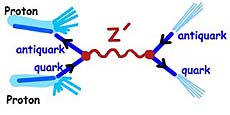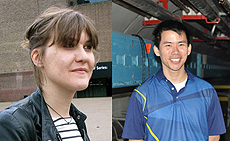Hidden interactions of quarks
 |
| The hypothetical Z' boson could be produced in proton-proton collisions. It would then decay into quark-antiquark pairs.
|
You've likely heard that there are four elementary forces (or interactions) in nature. With the 2012 discovery of the Higgs particle, we can now talk of a fifth force. Let's call it the Higgs force.
All five forces are understood as being mediated by some particles generically called bosons. These are the photon (mediator of electromagnetism), the graviton (mediator of gravity), the gluon (mediator of the strong force), the W and Z bosons (mediators of the weak force), and the Higgs boson. The Higgs force, like the weak and strong forces, acts only at very short distances, and its effects on macroscopic objects cannot be detected.
Quarks, the building blocks of most things around (and within) us, experience all five elementary forces. One of the questions explored by particle physics is whether there might be additional forces acting on quarks. A hypothetical force of this kind can be mediated by a particle called the Z' (read "Z prime") boson, which is hidden for now, presumably because of its short lifetime and large mass. The experiments at the Large Hadron Collider are searching for Z' bosons of mass up to a few thousand GeV; 1 GeV is slightly more than the proton mass.
There is, however, another way for the Z' boson to hide: If its interaction with quarks is feeble, then it is difficult to produce and detect in experiments. For example, if a Z' particle has a mass of only a few GeV and an interaction strength a few times smaller than that of the photon, then low-energy experiments do not yet have sufficient intensity to produce it, and direct searches at the LHC are hampered by large backgrounds.
Fermilab theorists have recently derived a new upper limit on the strength of the Z' force. This arises from self-consistency conditions within theories that include a Z' boson, in combination with collider searches for other particles, called vector-like fermions. Nevertheless, plenty of room for Z' bosons remains to be explored in experiments.
A related intriguing possibility is that Z' bosons interact not only with quarks but also with the mysterious dark matter that dominates the mass of the universe. In that case, the scattering of protons on nuclei may produce a beam of dark matter. The protons from the Main Injector, currently Fermilab's highest-energy accelerator, could produce such dark matter beams, while neutrino detectors on the Fermilab site (NOvA, MINOS and the future LBNF) may then probe the presence of dark matter particles.
The searches for the Z' particle demonstrate the synergy between experiments at the energy and intensity frontiers in conjunction with theoretical constraints.
—Bogdan Dobrescu
 |
| Postdocs Claudia Frugiuele and Felix Yu, from the Fermilab Theoretical Physics Department, are experts in physics beyond the Standard Model.
|
|